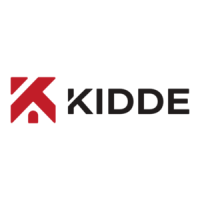System Design
April 2020 3-18 06-237619-001
In hazards with a suspended ceiling, consideration shall be given to having nozzles in the
ceiling void performing a simultaneous discharge in order to equalize the pressure during
discharge. This reduces the risk of unnecessary damage to ceiling tiles and such. Nozzles in
ceiling voids can be installed upright directly from a tee or elbow from the branch pipe.
Also, nozzles in room voids shall be installed in such a way that the jets from the nozzles do
not damage the ceiling tiles during discharge (i.e. the nozzles shall be positioned vertically with
the discharge holes free of the ceiling tiles and/or escutcheon plates). For lightweight ceiling
tiles, it is a requirement to securely anchor all tiles within 4.9’ (1.5 m) of each discharge nozzle.
In hazards with a raised floor (not gas tight) consideration shall be given for having nozzles
installed in the floor void to perform a simultaneously discharge in order to equalize the
pressure and achieve the extinguishing concentration below the floor.
In hazards such as server rooms, requirements to the release and equipment shut down
sequence may be needed as well as number of nozzles installed sufficient for providing the
design concentration between rows of server cabinets.
A range of nozzles, ½” to 1 ½”, with orifices from 3mm to 26mm can be provided. Nozzles
have a 180° or 360° discharge pattern. Nozzles can be installed pendant or upright.
3-15.1 Nozzle Coverage
The maximum area coverage of the installed nozzle is 1250 sq ft (116 sq m).
In enclosures higher than 16.0 ft (4.88m), nozzles may need to be positioned using a using a
two tiered nozzle arrangement. The nozzles can be mounted in the vertically up or pendant
down position.
3-15.2 Nozzle Selection and Placement
Use the Kidde IGS Flow Calculation software to determine the required orifice area and nozzle
size. There are two Kidde IGS nozzle configurations:
• The 360° nozzle provides a full 360° discharge pattern designed for placement in the center
of the hazard.
• The 180° nozzle provides a 180° discharge pattern designed for placement adjacent to a
side wall of the hazard.
The maximum orifice area to pipe area ratio must conform to the following:
• The ratio between the nozzle orifice area for a 360° nozzle at the given node and the pipe
cross sectional area for the pipe segment preceding that nozzle is 0.85, or 85%.
• The ratio between the nozzle orifice area for a 180° nozzle at the given node and the pipe
cross sectional area for the pipe segment preceding that nozzle is 0.85, or 85%. Due to
geometric constraints and the need to keep a sharp-edged orifice, in sizes up to and includ-
ing 3/4 in NPT (19 mm), the 180° sidewall nozzle has a lower ratio of orifice area to feed
pipe area. This value is different for each size nozzle through 3/4 in (19 mm) NPT.
The minimum orifice area to pipe area ratio must conform to the following:
• The ratio between the nozzle orifice area for a 360° nozzle at the given node and the pipe
cross sectional area for the pipe segment preceding that nozzle is 0.20, or 20%.
• The ratio between the nozzle orifice area for a 180° nozzle at the given node and the pipe
cross sectional area for the pipe segment preceding that nozzle is 0.20, or 20%.
Nozzles are available in nominal pipe sizes of 1/2 in, 3/4 in, 1 in, and 1-1/2 in (13mm,
19mm, 26mm, and 38mm). Nozzles are available in NPT or BSP fittings.

